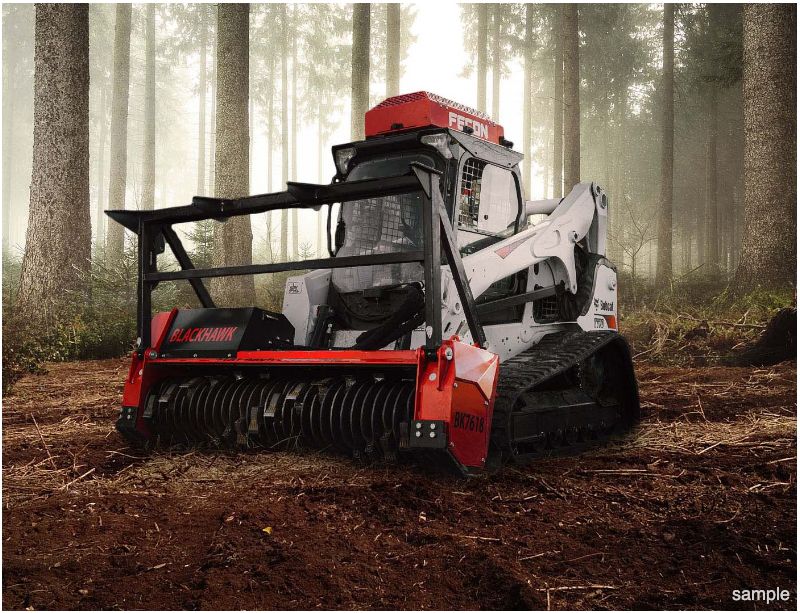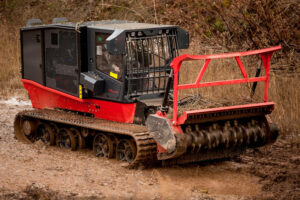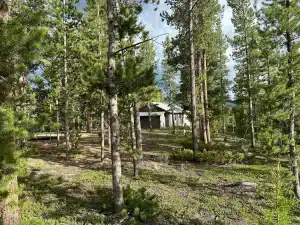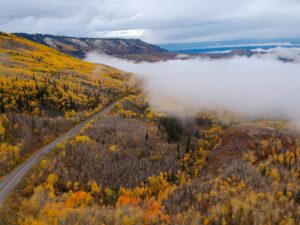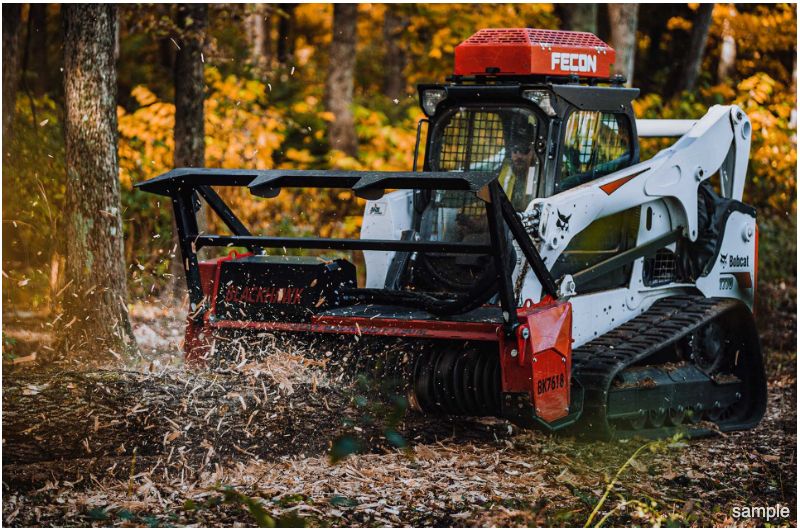
Forestry mulching is a land clearing method that uses a machine equipped with a rotating drum to shred and grind vegetation, such as trees, shrubs, and other vegetation, into small chips. The process typically involves cutting trees and vegetation down to ground level, and then grinding the material into mulch, which is left on the ground as a natural cover.
Forestry Mulching Equipment
The equipment used for forestry mulching is often referred to as a forestry mulcher, a mulching machine, or a brush cutter. It can be mounted on various types of heavy machinery, such as excavators, skid steers, or tractors. The forestry mulcher’s drum is made up of carbide teeth or knives that rotate at high speeds, shredding and pulverizing trees and other vegetation quickly and efficiently.
Advantages of Forestry Mulching As Land Clearing Method
Forestry mulching has several advantages over traditional land clearing methods such as bulldozing or burning. It is more environmentally friendly as it leaves the natural vegetation as mulch, which helps to retain moisture, prevent soil erosion, and improve soil health. It also eliminates the need for burning, which can be hazardous and release harmful pollutants into the air. Additionally, it can be faster and more cost-effective than other land clearing methods.
Forestry Mulching vs. Bulldozing
Forestry mulching is often considered a better land clearing method than bulldozing for several reasons:
- Environmentally friendly: Forestry mulching is a more environmentally friendly method of land clearing as it leaves the natural vegetation as mulch, which helps to retain moisture, prevent soil erosion, and improve soil health. In contrast, bulldozing can be more damaging to the environment as it often removes all vegetation and can result in soil erosion, habitat loss, and destruction of wildlife.
- Cost-effective: Forestry mulching is often more cost-effective than bulldozing. Bulldozing requires the use of heavy equipment and often results in the need for additional hauling and disposal of debris. In contrast, forestry mulching eliminates the need for hauling and disposal of debris, as the vegetation is left on the ground as mulch.
- Faster: Forestry mulching can be faster than bulldozing, especially in areas with dense vegetation. The mulching machine can clear large areas quickly and efficiently, without the need for additional grading and leveling.
Overall, forestry mulching is a more environmentally friendly, cost-effective, faster, and safer method of land clearing compared to bulldozing.
Will A Forestry Mulcher Grind Stumps?
Forestry mulchers are designed to clear land by cutting down trees and other vegetation, typically up to a certain diameter, and mulching the debris into small pieces. While some forestry mulchers may be able to grind stumps, it depends on the size and hardness of the stump, as well as the capabilities of the specific mulcher.
Some mulchers may be able to grind smaller stumps (up to a few inches in diameter) as part of their normal operation. However, larger stumps or stumps that are particularly hard or dense may require a specialized grinding attachment or a dedicated stump grinder to be removed effectively.
Depending on the situation, it may be more efficient and cost-effective to use a dedicated stump grinder or other specialized equipment. Additionally, grinding stumps with a mulcher can create a significant amount of debris and may not be suitable for all types of terrain or environments.
How Big Of A Tree Can Forestry Mulchers Take Down?
The size of the tree that forestry mulchers can take down depends on several factors, including the machine’s size and horsepower, the type of vegetation, and the density of the vegetation. Generally speaking, forestry mulchers can handle trees up to 8-12 inches in diameter, but they can take down larger trees under the right conditions.
Some larger mulchers can handle trees up to 20 inches in diameter, but this depends on the type of vegetation and the machine’s power. Additionally, forestry mulchers can be used to clear brush, shrubs, and smaller vegetation, which is often more efficient and cost-effective than traditional land clearing methods.
It’s important to note that forestry mulching is not suitable for all types of vegetation or terrain. For example, steep slopes or rocky terrain may be difficult for the machine to navigate, and certain types of vegetation, such as bamboo or vines, may not be effectively cleared with a forestry mulcher. It’s best to consult with a professional land clearing service to determine if forestry mulching is a suitable option for your specific needs.
How Long Does It Take For Forestry Mulch To Decompose?
The time it takes for forestry mulch to decompose depends on various factors, such as the type of material being mulched, the size of the pieces, the weather conditions, and the microbial activity in the soil.
Generally, smaller pieces of mulch will decompose faster than larger ones. In ideal conditions, such as warm and moist soil with ample microbial activity, forestry mulch can decompose within a few months to a year. However, in less favorable conditions, such as dry or compacted soil with limited microbial activity, decomposition may take several years or more.
It’s worth noting that while forestry mulch decomposes, it can provide a range of benefits to the soil, such as improving moisture retention, reducing erosion, and adding organic matter. Additionally, as the mulch breaks down, it releases nutrients back into the soil, which can benefit plants and other organisms.
How Many Acres Can A Forestry Mulcher Clear In One Day?
The amount of land that forestry mulchers can clear in a day can vary widely depending on various factors, such as the size and power of the mulcher, the density and type of vegetation being cleared, and the terrain and accessibility of the site.
On average, a forestry mulcher can clear between 1 to 4 acres per day. However, this is a very rough estimate and can vary widely based on the specific conditions of each site. For example, a large, powerful mulcher may be able to clear more land in a day than a smaller, less powerful one. Similarly, clearing dense, mature forests will typically take longer than clearing more open areas with smaller trees and vegetation.
What Size Skid Steer Is Needed To Run A Forestry Mulcher?
The size of the Bobcat needed to run a forestry mulcher depends on the size of the mulcher, the type of vegetation being cleared, and the terrain. Generally, a Bobcat with a minimum horsepower of 90 HP & 35 GPM of hydraulic flow is required to run a forestry mulcher efficiently.
The mulcher attachment itself will also have specific requirements that need to be met, including hydraulic flow and pressure ratings. Therefore, it’s important to make sure that the skid steer is compatible with the mulcher attachment before beginning any work.
It’s also worth noting that not all skid steers are suitable for forestry mulching. The machine must have enough hydraulic power to run the mulcher attachment, and the weight and size of the skid steer must be appropriate for the type of terrain and vegetation being cleared. In some cases, a larger machine, such as a skid steer loader or a compact track loader, may be needed to effectively clear the vegetation.
Ultimately, the size of the skid steer needed to run a forestry mulcher will depend on a variety of factors, and it’s best to consult with a professional land clearing service to determine the appropriate equipment for your specific needs.
Will Grass Grow After Forestry Mulching?
Grass can grow after forestry mulching. In fact, one of the benefits of forestry mulching is that it can improve soil health and promote the growth of new vegetation, including grass. The mulch left behind by the machine helps to retain moisture in the soil, which can be beneficial for grass growth.
However, the speed and success of grass growth after forestry mulching may depend on several factors, including the type of soil, the type of grass, the climate, and the amount of sunlight and water available. It’s important to properly prepare the soil and choose the right type of grass for the specific conditions in the area.
Additionally, it may take some time for the grass to establish itself after forestry mulching, as the mulch can take time to decompose and release nutrients into the soil. In some cases, it may be necessary to add additional soil amendments or fertilizers to promote grass growth.
Overall, while forestry mulching can promote grass growth, it’s important to properly prepare the soil and choose the right type of grass to ensure successful establishment.
Forestry Mulching Contractor
If you’re looking for a professional forestry mulching contractor for your residential, commercial, municipal, government, or forestry project, look no further!
Bear Claw Land Services is the Rocky Mountain West’s Premiere forestry mulching, land clearing, and fire mitigation contractor. Our mission is to deliver 5 star service on every project.
Whether you have a 1, 100, or 1,000 acres, Bear Claw Land Services has you covered. We own & operate only the best equipment including Bobcat, Caterpillar, Fecon, Prime Tech, and Prinoth to name a few and employe top notch operators to ensure you get quality every single time!
Give us a call at 970-363-4837 or tell us more about your job on our contact page.

